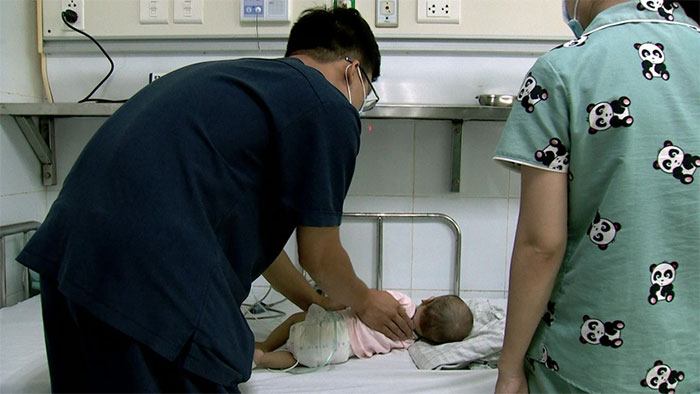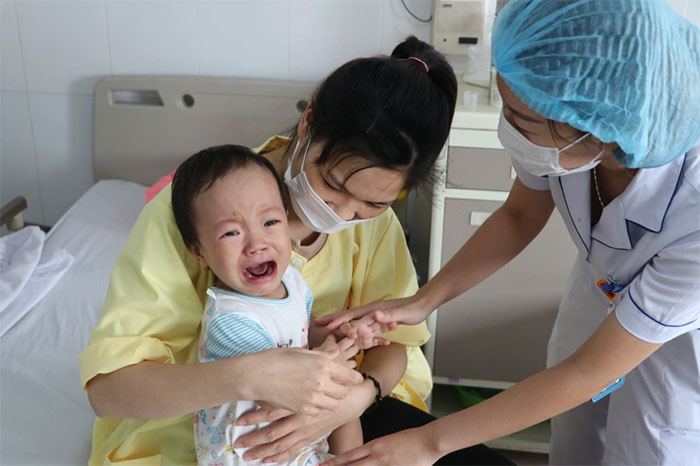Unlike before, patients with Influenza A can now exhibit severe neurological symptoms.
Recently, the Central Pediatrics Hospital in Hanoi received a case of a 6-month-old infant from Ha Tinh, who was admitted in critical condition due to severe respiratory distress caused by Influenza A. The child required oxygen therapy, respiratory support, and faced the risk of needing intubation and mechanical ventilation.
More notably, this infant had a pre-existing condition of pneumonia. Consequently, the respiratory infection was already quite severe, and the addition of Influenza A further exacerbated lung damage, leading to rapid respiratory failure.
After several days of ineffective treatment at a local hospital, the child was fortunate to receive timely and intensive care at the Central Pediatrics Hospital, avoiding the need for intubation and mechanical ventilation. Had that occurred, the hospitalization and treatment duration could have been significantly prolonged.
According to doctors, the infant’s health is currently improving, and they may be discharged in the coming days.

The 6-month-old patient from Ha Tinh receiving respiratory support during treatment. (Photo: TL).
However, the medical facility reports that this is not the only case. Over the past three weeks, the number of children infected with Influenza A has shown an increasing trend, with a significant rise in hospital admissions due to this illness.
Similarly, at the Pediatrics Department of the Central Tropical Hospital, the number of patients hospitalized due to Influenza A has risen unusually compared to previous years.
Specifically, among the hundreds of cases examined daily, doctors found that 20-25% of the total patients had Influenza A.
Not only affecting young children, the Outpatient Department of the Central Tropical Hospital has also received nearly 100 cases of Influenza A in the past two weeks, including young adults aged 20-30 and the elderly.
Notably, among these cases, the hospital has recorded instances of severe progression. Moreover, experts have noted that the manifestations of Influenza A have been changing in a more dangerous direction in recent years.
New Neurological Symptoms
In discussions with the media, Dr. Do Thien Hai, Deputy Director of the Tropical Disease Center at the Central Pediatrics Hospital, stated that common symptoms of Influenza A in young children include persistent high fever above 38.5-39 degrees Celsius, unresponsive to antipyretics, poor appetite, fatigue, and in some cases, seizures.
However, the expert indicated that the progression of Influenza A has changed significantly compared to previous years.
He remarked: “About 10 years ago, patients with Influenza A typically only exhibited upper respiratory tract symptoms along with fever. There were no neurological symptoms. However, since the flu season of 2019-2020, we have observed distinctly severe neurological symptoms.”
Dr. Hai cited examples of cases of Influenza A examined during this timeframe, noting that there were additional symptoms of seizures in up to 45% of cases. Notably, about 6% of young children infected with the Influenza A virus exhibited signs of encephalitis.
From this, he concluded that Influenza generally has a benign course, with patients recovering within approximately 2-7 days. However, in children, especially those with pre-existing conditions, Influenza A can progress more severely and is prone to complications.

Dr. Do Thien Hai, Deputy Director of the Tropical Disease Center at the Central Pediatrics Hospital. (Photo: TL).
In agreement, Dr. Dang Thi Thuy, Head of the Pediatrics Department at the Central Tropical Hospital, emphasized: “Seasonal flu typically has a benign progression but can also lead to severe and dangerous complications in individuals with chronic cardiovascular and respiratory diseases.”
According to this expert, Influenza A is an acute respiratory infection that usually occurs during the winter-spring season, particularly during seasonal transitions (seasonal flu). Influenza A is caused by strains of the Influenza A virus such as H1N1, H5N1, H7N9, etc.
The disease spreads via respiratory droplets, from tiny droplets containing the virus released when an infected person coughs, sneezes, or touches contaminated surfaces and then touches their eyes, nose, or mouth.
“The initial symptoms of Influenza A or seasonal flu, in general, are quite similar to those of other respiratory virus infections. Children may experience fever, respiratory inflammation such as cough, sneezing, runny nose, sore throat, etc. Therefore, parents often find it challenging to distinguish whether their child has Influenza A or not,” Dr. Thuy noted.
However, in addition to the initial symptoms mentioned, the expert indicated that children infected with Influenza A typically experience high fever of 39-40 degrees Celsius, conjunctival injection, a completely reddened throat, fatigue, poor appetite, irritability, and in severe cases, may experience shortness of breath, pneumonia, or bronchiolitis.
At this point, parents should take their child to the nearest medical facility for diagnosis and advice on appropriate care and treatment based on each child’s condition.
Adapting to Changes in the Disease and Vaccination
According to Dr. Do Thien Hai, during times of disease outbreaks like the current situation, for diseases with vaccines, parents should review their child’s vaccination record to identify any missing vaccines and ensure timely immunizations.
In this regard, Dr. Dang Thi Thuy affirmed that currently, the most effective preventive measure against Influenza A remains proactive vaccination. The ideal time for vaccination is about three months before the transition between winter and spring (from July to September).
“At this time, the body will have enough time to produce the necessary antibodies to combat the virus,” the expert stated.
However, the Influenza A virus continues to mutate. After a year, antibodies gradually diminish. Therefore, Dr. Thuy also recommends that the public should receive annual booster vaccinations.

Influenza A patients being treated at the Central Tropical Hospital. (Photo: BVCC).
Regarding other preventive measures, Dr. Hai advises: “For Influenza A, when a child unfortunately contracts the disease, parents should inform the teacher or the management at the child’s gathering place so that other children can take timely preventive measures. For example, respiratory hygiene practices such as nasal drops and gargling with saltwater can reduce the risk of infection.”
Meanwhile, Dr. Thuy believes that parents should also focus on enhancing their child’s health through a balanced diet, and supplementation of necessary vitamins and minerals according to age.
Maintaining personal hygiene, such as washing hands with antibacterial soap or disinfectant before meals, after returning home, and after using the restroom, is also crucial.
Children should be encouraged to avoid touching their eyes, nose, and mouth. Additionally, parents and schools must regularly clean the living and play spaces of children, especially classrooms, toys, and items children come into contact with daily.
Dr. Thuy reiterated that Influenza A is a respiratory-transmitted disease. Therefore, families should avoid taking children to crowded places, especially avoiding contact with individuals who have the flu. Wearing masks when going outside is essential to limit transmission.

















































